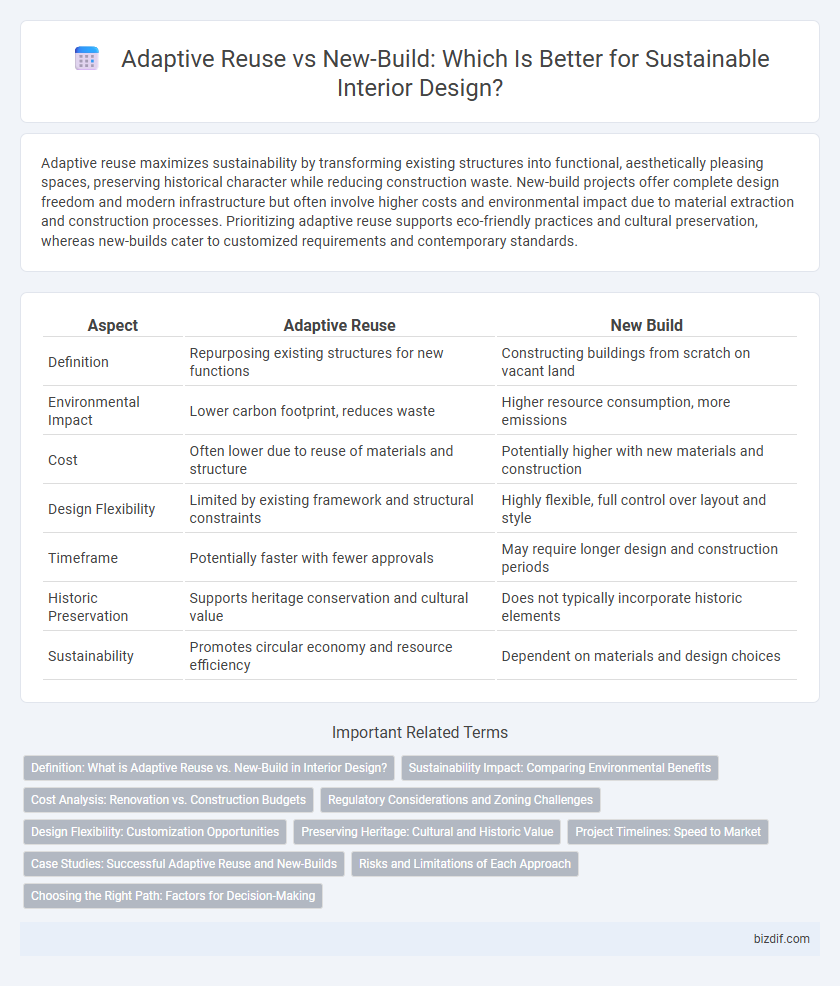Adaptive reuse maximizes sustainability by transforming existing structures into functional, aesthetically pleasing spaces, preserving historical character while reducing construction waste. New-build projects offer complete design freedom and modern infrastructure but often involve higher costs and environmental impact due to material extraction and construction processes. Prioritizing adaptive reuse supports eco-friendly practices and cultural preservation, whereas new-builds cater to customized requirements and contemporary standards.
Table of Comparison
| Aspect | Adaptive Reuse | New Build |
|---|---|---|
| Definition | Repurposing existing structures for new functions | Constructing buildings from scratch on vacant land |
| Environmental Impact | Lower carbon footprint, reduces waste | Higher resource consumption, more emissions |
| Cost | Often lower due to reuse of materials and structure | Potentially higher with new materials and construction |
| Design Flexibility | Limited by existing framework and structural constraints | Highly flexible, full control over layout and style |
| Timeframe | Potentially faster with fewer approvals | May require longer design and construction periods |
| Historic Preservation | Supports heritage conservation and cultural value | Does not typically incorporate historic elements |
| Sustainability | Promotes circular economy and resource efficiency | Dependent on materials and design choices |
Definition: What is Adaptive Reuse vs. New-Build in Interior Design?
Adaptive reuse in interior design involves repurposing existing buildings by modifying their interiors to serve new functions while preserving structural elements. New-build refers to designing and constructing interior spaces from scratch within newly erected structures, allowing complete customization. Both approaches impact sustainability, spatial planning, and material selection differently within architectural projects.
Sustainability Impact: Comparing Environmental Benefits
Adaptive reuse significantly reduces environmental impact by conserving existing materials and minimizing construction waste, lowering carbon emissions compared to new-builds. New-build projects typically demand greater energy consumption and resource extraction, increasing their carbon footprint throughout construction and operation phases. Prioritizing adaptive reuse promotes sustainability by extending building lifecycles and supporting circular economy principles in interior design.
Cost Analysis: Renovation vs. Construction Budgets
Adaptive reuse projects typically lower overall expenses by utilizing existing structures, reducing material costs and landfill fees compared to new-build developments. Renovation budgets often emphasize the unpredictability of hidden damages and the need for specialized labor, which can increase costs but generally remain more cost-effective than constructing from scratch. New construction requires significant investment in site preparation, permits, and infrastructure, driving budgets higher despite offering greater design flexibility.
Regulatory Considerations and Zoning Challenges
Adaptive reuse projects often face complex regulatory considerations such as compliance with historic preservation codes and retrofit requirements for safety and accessibility, which can be more stringent than those for new-builds. Zoning challenges for adaptive reuse include restrictions on changing the building's original use or density limits, whereas new-build projects must navigate site-specific zoning laws, setbacks, height restrictions, and land-use permits from inception. Understanding local building codes and engaging with municipal planning departments early is critical to successfully addressing the regulatory and zoning hurdles in both adaptive reuse and new construction scenarios.
Design Flexibility: Customization Opportunities
Adaptive reuse projects offer enhanced design flexibility by allowing architects to creatively customize existing structures, integrating modern elements while preserving historical features. New-build constructions provide complete freedom in spatial planning, enabling tailored design solutions from the ground up to meet specific client needs and innovative architectural trends. Both approaches deliver unique customization opportunities, with adaptive reuse emphasizing creative integration and new-build focusing on full design control.
Preserving Heritage: Cultural and Historic Value
Adaptive reuse of historic buildings preserves cultural and historic value by maintaining original architectural features and materials while integrating modern functionality. This approach supports sustainability by reducing demolition waste and conserving embodied energy, unlike new-build projects that often erase historical context. Preserving heritage through adaptive reuse fosters community identity and promotes a tangible connection to the past within contemporary interior design.
Project Timelines: Speed to Market
Adaptive reuse projects often have shorter project timelines compared to new-build constructions due to existing structural elements and infrastructure. The ability to repurpose materials and design elements accelerates the design and permitting phases. New-build projects typically require extensive site preparation, foundation work, and longer approval processes, delaying speed to market.
Case Studies: Successful Adaptive Reuse and New-Builds
Case studies such as the Tate Modern in London exemplify successful adaptive reuse, transforming industrial spaces into vibrant cultural centers while preserving historical elements. In contrast, new-build projects like the Apple Park campus in California showcase innovative design and sustainability from the ground up, emphasizing modern architectural techniques. Both adaptive reuse and new-build approaches demonstrate unique contributions to sustainable and functional interior design solutions.
Risks and Limitations of Each Approach
Adaptive reuse projects often face challenges such as structural limitations, code compliance issues, and hidden damages that elevate renovation costs and extend project timelines. New-build developments provide design flexibility and modern standards but involve higher initial capital expenditure and extended approval processes. Both approaches require careful risk assessment to balance budget constraints, sustainability goals, and long-term functionality.
Choosing the Right Path: Factors for Decision-Making
Adaptive reuse leverages existing structures to enhance sustainability, reduce costs, and preserve architectural heritage, making it ideal for projects within urban or historically significant areas. New-build construction offers greater flexibility in design, modern compliance standards, and optimized spatial layouts, better suited for sites with no existing structures or where customization is paramount. Key factors influencing the decision include budget constraints, environmental impact goals, site conditions, regulatory requirements, and the desired aesthetic or cultural value.
Adaptive reuse vs New-build Infographic

 bizdif.com
bizdif.com